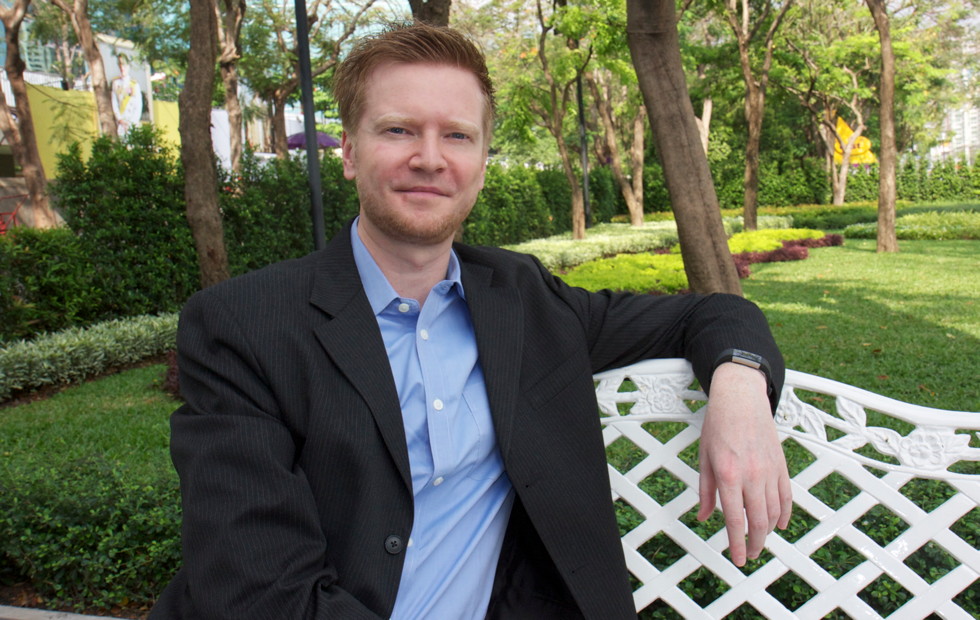The Dane Jan Mandrup works as Senior Digital Program Manager with IBM Asia, where he is also involved in developing IBM’s Agile Project Management competencies and certifying the company’s senior business project managers.

In today’s very dynamic, digital world that is transforming every sector, this combination creates curiosity about: what IBM offers these days (something else than the expensive hardware back in the early days) and what ‘agile business’ practices actually are.
Jan Mandrup is locally employed with IBM in Thailand and it is easy to see that one of life’s coincidences is what brought him to Asia. Though, he had indeed aimed for an international career by also studying at the International Business School in Copenhagen.
His Asian adventure started back when we was working at Maersk Data in Copenhagen and IBM acquired this IT division back in 2004, including its overseas subsidiaries. Jan was then sent to Japan to transform the operation and integrated the office there into IBM.
“After aligning all the services, I stayed another year and did a couple of projects for Maersk in Korea and Japan. I was 3,5 years there and on my way back to cold Denmark I looked around in the region as I really had got to like Asia. An opportunity in Thailand came up; a two year contract for a large business transformation project for a shipping company where they needed a project manager who knew shipping. It was a done deal.”
“I got to like Thailand and extended, and the two years have became over eight,” says Jan who also works on projects in the region, overseeing multiyear projects with large millions of U.S. dollar budgets. Recently he was one of the IBM experts flown in to Vietnam for a two-year project.
“I have worked for multiple large companies transforming their business processes and systems; both where manual processes are made digital and where existing digital processes and systems are to be optimized or redesigned to be more efficient.”

Usually his overall role is to ensure that major change initiatives are planned and executed smoothly and meet the strategic goals.
But where Jan laid foundation for his project management career was studying Electronics combined with an internship at a Danish hospital, where he worked as a medico technician and became an expert in structure troubleshooting and isolating problems.
“Repairing complex electronic equipment is all about systematic and logic fault-finding. This analytical mind-set is actually very useful in the field of project management because you cannot know all the skills of your team. But you need to be able to ask the right questions to drive them in the right direction. Through this you can easily get to the fact that they might not be able to see, because they are the experts sitting in the middle of the problem,” explains Jan.
He also points to that there, despite language barriers, definitively is a role for Westerners like him here in Asia thanks to being a westerner in the people-driven hands-on work:
“Successful projects is all about building the right team and project team culture so that people are actually not afraid to come and tell me when they have a problem. Normally that works and they actually appreciate that but they would likely not get that from an Asian project manager.”
The Dane thinks the most difficult thing here in Asia is that people are afraid of failure and consequently also of change. And mistakes do happen and must be allowed and, crucially, must be shared by all so they can find a way to fix it together. Nothing can lie unaddressed, sometimes for years, and pop up at the end. Jan’s way to get around it is to build a team culture of openness and it also helps to find someone in the team that is his trusted informant concerning all informal things going on in local language.
80 per cent of the time as a Program manager he spends dealing with people; including the team but also to manage various stakeholders and to remove road blocks for the specialists doing the technology side of things.
“And often you find yourself between the customer who just know what he wants to do, and the techies who are incapable of explaining something that the executive can understand so we need to bridge that gap.”
Clients are normally the large, international corporations that buy into IBM’s brand and the breadth of their skills. Rapidly expanding companies that are outgrowing technologies and require a complete system overhaul, or companies looking to digitise their manual processes to become more effective, is the typical scenario.
“For example, a company that has had growth or expanded or acquired and is now looking at streamlining the way they are doing business. The need is for modernizing and digitizing of their business processes to become more effective or get a competitive advantage, or they simply want to do it more consistently.”
Traditionally this would be done by implementing a ERP (Enterprise Resource Management) solution that can be customized to fit the specific business needs. The challenge in an ERP project is to get agreement and acceptance from all business stakeholders on one set of business processes and that is going to be the way to do things. This can be a BIG challenge especially in large organisation with multiple strong senior opinion makers.
“The area of large complex multiyear ERP projects is however getting more and more rare and instead many companies are adopting a more agile approach, implementing shorter agile projects that is solving specific problems instead, providing an end to end integrated process.”
Within IBM there is also a transformation going on from a traditional project approach to a agile culture. This is done through a network of agile ‘Agile Champions’ or Agile Project managers.
“To grow your career in IBM everyone is expected to give back and help build and promote skills besides their day-to-day job as a manager or consultant etc., Such as promoting agile project management skills,” he explains. “Today most projects are sold as agile projects which require me as the project or program manager to have the agile skillset but also be able to coach the team in becoming agile.”
“My experience is that only very few companies today are really agile. Most companies are still trying to get out from the traditional way of doing projects. Changing people’s mind is not easy. We are starting to see more and more people adopting an agile mind-set and actually seeing and embracing the agile way. But it is a tough transformation.”
“Many people believe: ‘Now I’m doing agile, so I can change anything at any time!’ That is absolutely not the truth. Agile is a powerful and different way of delivering a project by breaking it down in smaller more manageable pieces, lego’s so to speak which can be delivered in a short period of time and which can be verified or even used immediately. This reduces the risk of spending multiple years on a project, which at the end does not provide the expected benefits, do not work or even becomes obsolete before it has ever been completed.”
“One common perception is that in agile projects you do not need documentation or planning. That could not be more wrong. You do need a plan and you do need documentation but you need to find a balance so you keep the focus on the outcome and the product and embraces change.”
Jan describes it primarily as a different mind-set, and points out that it does not work for everything.
“To be successful in Agile you need to unlearn the traditional waterfall project approach – where you have gone through a very rigid process of documenting your needs, with rigid large requirement documents which you will not see if works until the end of the project.”
The traditional project method entails the risk of an extremely costly failure if you spend two years doing a project that at the end does not provide the expected outcome.
“You need to get away from that thinking and ask: ‘What is it I want to do? What is my end state, and how do I get there?’ I don’t get there by taking one big step that takes me two years. I get there by smaller steps, which I can validate or even start using along the way. So, at least, after two years everything will not fail because I have had things that worked and were completed along the way.”
“The difficulty with this is that sometimes you cannot do it, because there are certain things that you cannot break down into pieces. If you go with the mentioned end-to-end ERP solution it is very hard to go live with only a piece of the end of the chain – you need to have a workable end-to-end process; this is why ERP solutions have a reputation to be very complicated, costly and have high degree of risk.”
“Because of the risk in ERP systems, many companies are now looking at different ways of doing digital transformation where they do many smaller projects and connect the projects together instead of a large end-to-end ERP project.”
Digital transformation is unavoidable when portraying the services of today’s IBM. “Our mission is to become the digital innovation partner and everything we do is linked to digital; it is either transforming something existing into a better way or to build something that doesn’t exist today, or to innovate and replace manual tasks using intelligent technology.”
“It is interesting to see how digital transformation in Europe is very much driven by cost-effectiveness as in the western countries labour is extremely expensive, while here in Asia I find that the motivator is not so much cost efficiencies as labour is much cheaper. Instead digitalisation is more driven by pressure from competitors doing it and companies are afraid of losing out. So it’s more profit-driven.”
Of course, in industries under pressure from external factors, for example the shipping industry with failing freight rates, constantly need to find savings, so they must transform to survive.”


